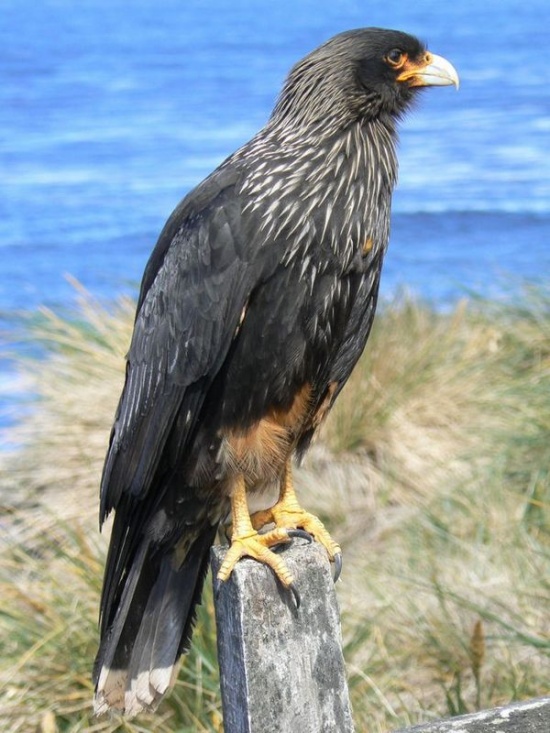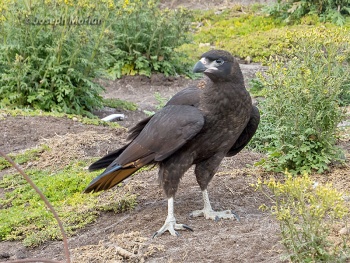| Line 5: | Line 5: | ||
L 64 cm (25") W 116-125 cm (46-49")<sup>[[#References|[5]]]</sup> <br /> | L 64 cm (25") W 116-125 cm (46-49")<sup>[[#References|[5]]]</sup> <br /> | ||
'''1st year (juvenile)'''<br /> | '''1st year (juvenile)'''<br /> | ||
| − | *Dark brownish-black, nape with iridescent brown flecks | + | *Dark brownish-black, nape with [[Dictionary G-L#I|iridescent]] brown flecks |
*Tail with gold sheen | *Tail with gold sheen | ||
*Paler [[Topography#Wings|primaries]] with bluish trim | *Paler [[Topography#Wings|primaries]] with bluish trim | ||
| − | *Pale grey legs, feet and | + | *Pale grey legs, feet and [[Topography#Heads|cere]] |
*Bill mostly dark<br /> | *Bill mostly dark<br /> | ||
'''2nd year<br />''' | '''2nd year<br />''' | ||
| Line 15: | Line 15: | ||
'''3rd year <br />''' | '''3rd year <br />''' | ||
* Streaking extends to breast | * Streaking extends to breast | ||
| − | * Legs, feet and | + | * Legs, feet and [[Topography#Heads|cere]] become yellow-orange |
* Bill becomes paler, blue-gray<br /> | * Bill becomes paler, blue-gray<br /> | ||
'''4th year <br />''' | '''4th year <br />''' | ||
| Line 25: | Line 25: | ||
* Tail tip with white bars | * Tail tip with white bars | ||
* Legs and feet bright yellow-orange | * Legs and feet bright yellow-orange | ||
| − | * | + | * [[Topography#Heads|cere]] orange |
* Bill pale blue-gray<br /> | * Bill pale blue-gray<br /> | ||
| − | + | Streaking continues to become whiter with age.<sup>[[#References|[1]]]</sup> | |
==Distribution== | ==Distribution== | ||
Revision as of 19:37, 20 May 2018
- Phalcoboenus australis
Identification
L 64 cm (25") W 116-125 cm (46-49")[5]
1st year (juvenile)
- Dark brownish-black, nape with iridescent brown flecks
- Tail with gold sheen
- Paler primaries with bluish trim
- Pale grey legs, feet and cere
- Bill mostly dark
2nd year
- Primaries more rufous
- Pale culmen
3rd year
- Streaking extends to breast
- Legs, feet and cere become yellow-orange
- Bill becomes paler, blue-gray
4th year
- Streaks become grayish, less brown
- Thigh feathers rufous
- Tail white tipped
5th year
- Steaking light gray
- Tail tip with white bars
- Legs and feet bright yellow-orange
- cere orange
- Bill pale blue-gray
Streaking continues to become whiter with age.[1]
Distribution
Falkland Islands and Tierra del Fuego. In decline in both areas and in the Falklands restricted to West Falkland and islands off the west coast, in the south of Falkland Sound and Sea Lion Island and Beauchene Islands south of East Falkland. In Tierra del Fuego found on the southern coast and on islands in the south of the Beagle Channel. Resident.
Taxonomy
Monotypic. [2]
Habitat
Found on shorelines and scavenges in seabird colonies.
Behaviour
Primarily a scavenger, it will attack weak or disabled creatures, even ones as large as a sheep. The diet includes land and marine invertebrates, sometimes using its strong legs and blunt, strong claws to dig for them.
The nest is built on the ground or on a cliff ledge, and up to 4 eggs are laid.
References
- Avibirds
- Clements, J. F., T. S. Schulenberg, M. J. Iliff, D. Roberson, T. A. Fredericks, B. L. Sullivan, and C. L. Wood. 2017. The eBird/Clements checklist of birds of the world: v2017, with updates to August 2017. Downloaded from http://www.birds.cornell.edu/clementschecklist/download/
- Bierregaard, R.O., Jr, Kirwan, G.M. & Garcia, E.F.J. (2018). Striated Caracara (Phalcoboenus australis). In: del Hoyo, J., Elliott, A., Sargatal, J., Christie, D.A. & de Juana, E. (eds.). Handbook of the Birds of the World Alive. Lynx Edicions, Barcelona. (retrieved from https://www.hbw.com/node/53192 on 16 May 2018).
- BirdLife International. 2016. Phalcoboenus australis. The IUCN Red List of Threatened Species 2016: e.T22696247A93551504. http://dx.doi.org/10.2305/IUCN.UK.2016-3.RLTS.T22696247A93551504.en. Downloaded on 16 May 2018.
- Jaramillo, A. 2003. Birds of Chile. Princeton & Oxford: Princeton Univ. Press. ISBN 978-0691117409
- Wikipedia
- BF Member observations
Recommended Citation
- BirdForum Opus contributors. (2024) Striated Caracara. In: BirdForum, the forum for wild birds and birding. Retrieved 27 April 2024 from https://www.birdforum.net/opus/Striated_Caracara





